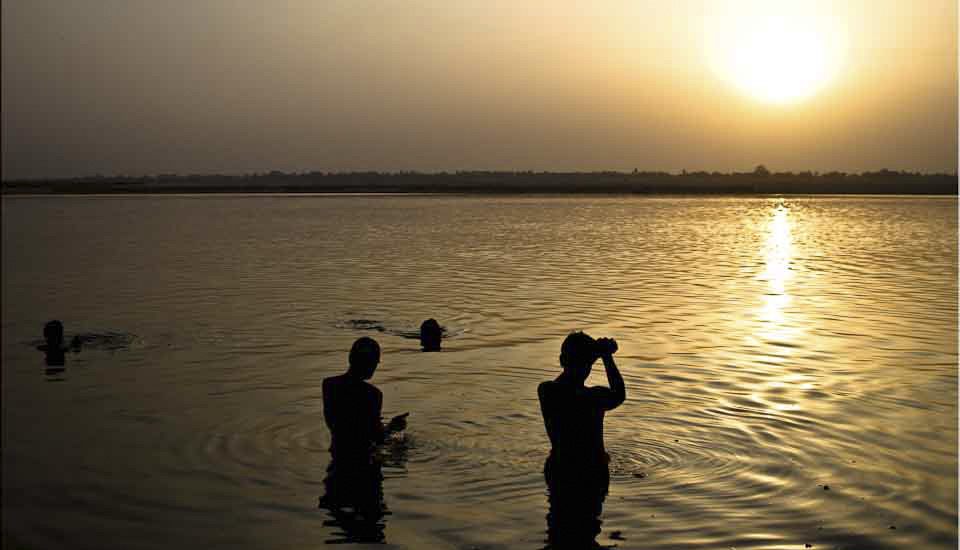.jpg)
Woman in a Red Ghoonghat
India is about colour: everywhere you look, people in colourful clothing contrast wildly with colour-washed walls and chaotic backgrounds.
India is an intensely sensory experience.
For me – a Westerner who grew up in a conservative culture of lowered voices and subdued shades in the northern prairie lands of snow and open spaces – the colours, the smells, the heat, and the press of the crowds in India can quickly lead to sensory overload. This is especially true during festival times.
But, I love it!
Here in Australia at the moment – thanks to the Novel Coronavirus – we are entering our sixth month of restricted movements, with the Australian borders closed to virtually all international travel in or out. Even our internal borders are closed, and many communities are enduring weeks of strict lockdown. All my travel plans for the the year have had to be postponed or cancelled.
So, the only way I can travel is vicariously by exploring archives of old images. What better antidote for Social Distancing than to return to pictures I took during what has been called the world’s biggest religious gathering: India’s Kumbh Mela.
The Kumbh Mela or Kumbha Mela is a major Hindu pilgrimage and festival. According to the story, back when the gods lived on the earth, they fought continuously with demons over a pot (kumbha) of amrita, the nectar or elixir of immortality. During the struggle, drops of the elixir fell on four earthly sites: Allahabad (the confluence of the Ganges and Yamuna Sarasvati Rivers), Haridwar (Ganges), Nashik (Godavari), and Ujjain (Shipra). Roughly every three years, the Sun, the Moon, and Jupiter line up over one of these sites, and the associated rivers turn back into the original primordial nectar. Pilgrims bathing in the sacred waters at these auspicious times are eternally blessed by the divine, and their sins are washed away.
So, when the Hindu Holy Men calculate the propitious dates, the Hindu pilgrims come. They come from all over India. They come to bathe and pray, and they come to transport water from the sacred rivers home with them.
I – along with photographers Gavin Gough and Matt Brandon and a small group of intrepid photography enthusiasts – was one of the more than 10 million people who descended upon the ancient city of Haridwar in Uttarakhand, North India to attended the 2010 Kumbh Mela.
There, amid the crush of bodies, my cameras and I revelled in the colours of the occasion.
.jpg)
Colours of India
Colour is everywhere: in the bright and wildly patterned saris and ghoonghats (headscarves), in the vibrantly painted walls of the old brick buildings, and in the chaotic array of goods for sale.
.jpg)
Shisha Mirror Embroidery
Many of the fabrics people wear are elaborately embroidered with rich threads and and small mirrors.

Pilgrim in Cream
Even the more subdued colours are lit up by the smiles of their wearers.

Lace Trim Border
Cotton lace edging frames faces and contrasts with the main fabric.

Hands
Women carry their wealth in the gold bangles they wear. More than one woman I met thought me rather ‘poor’ because of the lack of gold jewellery on my person!

Sadhu in Orange
The Holy Men come in a range of colours and styles. Check out that hair!

Colourful Scarf
Everywhere I go, I meet smiling faces and a direct gaze.

Orange Bridge over the Ganges
Even the bridges across the sacred mother Ganga are brightly painted.

Sadhu on the Move
Some of the pilgrims have walked for days to get here …

Time Out
… so a break with friends is always welcome.

Overlooking the Camp
To handle the massive influx of humanity, a vast tented camp area has been set up. Monitoring is low-key, and performed by local police in subdued uniforms.

Lady in Red
Sheer fabrics often act as a face cover – but the gaze is still direct.

Fresh Laundry
Saris, turbans, and ghoonghats all require metres of colourful cloth.

Women in Bindis
Red forehead dots (bindis) placed on the third eye of spiritual sight are commonly worn by married women, particularly Hindus and Jains, across the subcontinent.

Sadhu in a Tilaka
While bindis have a range of uses and meanings, tilak or tilaka are more specific, acting as a holy mark of religious affiliation. The three lines are a reminder of the various sacred triads in Hindu thought.

Child in Sunnies
Pilgrims come in all ages.

Women in a Tent
In the dim shade of fabric tent a group of women have gathered. They invite me to join them.

Woman in a Purple Tent
The purple fabric contrasts with the women’s colourful headscarves.

Colourful Woman
The woman are all smiles and chatter …

Indian Woman
… and there is plenty of food and drink in the tent with them.

Woman in Blue

Young Woman in Yellow
The purple fabric casts interesting lights on the young women in the tent.

A Splash of Sari Colour
Back outside, the light and heat bounce off the corrugated iron sheeting that lines the corridors of the pilgrim’s camp.

Mother and Daughter

On the Bathing Ghats
In Hindi, a ghat is the “river landing stairs”, and the place where pilgrims gather to bathe in the Ganges as it races past.

Young Woman on the Ghats

Woman in an Ornamental Bindi

The Face of Experience

Rusty Rails
Away from the ghats, crowds are thinner, but the colours and textures continue.

Child on a Balcony
As I make my way back through the arterial roads, a child watches my retreat from overhead.

It was time for me to return to the relative quite of my small room.
As I said, as much as I love the colours of India, they overwhelm me, and I have to retreat.
But, I’ll be back!
As soon as our travel bans are lifted …
Photos: 13April2010

































.jpg)

